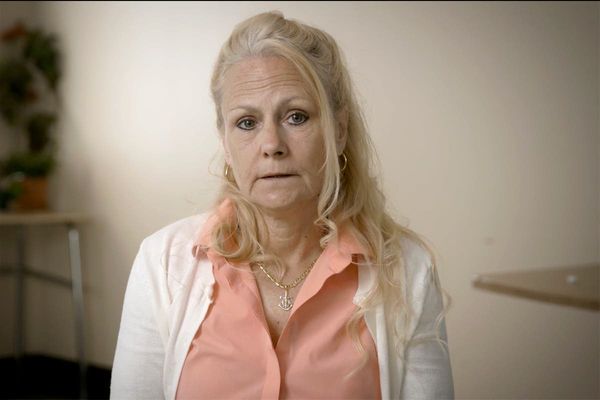
Twice a week, I’ve been taking my dog down the road for a 10-pack of chicken nuggets. We sit in the car park at Macca’s and I have a bite to “check if it’s hot” before passing them across to her. She knows the routine. She knows the smell when we arrive and the sounds of the machines. And she knows that before we can go to the drive-thru we have to stop at the vet to have her bandages changed.
I do this because she loves nuggets, but also because, despite my asking nicely that she please stop, my dog is slowly dying.
For 13 years, Joss has been my shadow. Every time I turn around, I trip over her. She gets clipped by the wheels of my computer chair and rushes to join me in the bathroom. At night, her soft grunts float up from the floor next to my bed.
One morning three months ago, I called Joss for breakfast and she didn’t come. I knew the only reason would be because she couldn’t. I found her in the living room. She was trying to stand but her back legs weren’t moving. I wrapped her in a blanket, told her she was brave and lifted her into the car. While I cried and drove, she pushed her nose into my elbow.
She underwent surgery, which went as well as it could have, but her long-term prognosis is not good. Our vet, Dan, says we still have a few good months together – “maybe even six”. Every day Joss seems a little slower than the one before, her days of running and playing long past, and most of her time is spent sharing her new orthopaedic bed with a small cat.

When I’ve told friends and family about Joss, their first reaction – even before “oh no” – is to lament the cost.
While I would do anything to help her, money is finite and my buffer is waning. I have one big bill left in me and then I’ll have to stop, and that will be the end.
A vet mental health crisis
Sophie Putland was always a gentle, empathetic person whose love of animals trumped all else, her dad Garry Putland says. There was never any question that she would become a vet. She was “the vet you wanted at your side when your pet was ill”, Garry told the ABC earlier this year.
But after years of working under increasingly stressful conditions, an altercation with an aggressive client was the last straw for Sophie, her dad says. “Her incident was with a male who was making unreasonable demands on her and then just absolutely lashed out. The owner of the clinic was fantastic with her, but I think the damage had been done.”
Within weeks, Sophie had taken her own life. And she’s not alone. In Australia, vets are four times more likely to suicide than the general population – and nearly 70% of them have lost a colleague or peer this way.

Through the organisation Sophie’s Legacy, Putland is now working to change the public’s mindsets about vets – to treat them “like humans”.
Last year the group surveyed vets to find out why their mental health was suffering so badly. “The top issues were things like unreasonable demands by clients and snide comments, often about costs,” Putland says. “Then the one which we were really surprised by – client abuse.”
He says vets are copping aggressive, sometimes violent behaviour from clients, and the survey showed it’s often linked to bill shock.
Vet care is objectively expensive, especially when compared with our own healthcare. Bills often come with little notice and require immediate payment. Add in the cost-of-living crisis and these bills can be life altering.
Putland told a recent NSW parliamentary inquiry into vet workforce shortages that clients often expect animal healthcare to cost the same as that for humans, which is free or subsidised through Medicare.
“We need to set that expectation that when you buy a pet, it could be costly,” he says.
What does a dog really cost?
A 2021 report found Australian households spend just over $3,200 a year per dog, on average. This is not including the initial cost of purchasing the dog. Finnish lapphunds have a life expectancy of about 15 years, which roughly makes Joss a $50,000 investment.
Diana Barker, the president of the Australian Veterinary Association, which contributed to the report, says it is important to realise that those costs vary significantly over a pet’s lifetime, largely coming at the beginning and the end.
“With puppies, you’ve got all the preventive care costs: vaccinations, health checks, and then you’ve got food, vaccination, health checks, parasite control and training. So for the first one to two years of their life there are significant costs.”
Think up to $6,000 in the first year alone, according to this government budgeting website. Things get better – for a while, at least. “After the first two years [come] the easy years,” Barker says. “And then as they get a bit older, things do start to go wrong.”

Different breeds can be predisposed to specific challenges: German shepherds have famously bad hips; bulldogs and other brachycephalic breeds can have respiratory issues; and cocker spaniels can go wrong in almost every way imaginable. Just like us, a dog might need scans, daily medication, surgeries or even hospital care. Unlike us, there’s no government program in place to offset the cost.
Barker says the breed we choose can play a substantial role in the cost of caring for a dog over its lifetime. She mentions the popular French bulldog as an example. “We know that they have issues with their airways and can have breathing difficulties as they get older. They also can have spinal malformations and problems. Same with dachshunds – they’ve got those really long spines.”
Hard conversations
Mardi Lacey, a nurse who lives on Kangaroo Island, understands this all too well. In 2018 she and her husband Craig brought home Frank – “our baby” – a red dachshund puppy.
“He needed an osteotomy at six months old,” she tells me. “That’s where they cut their bone in half.” That operation was only the beginning of the Frank-related expenses. Over his lifetime Frank faced snake bites, stomach obstructions and the consequences of eating things he shouldn’t.
Lacey says they ended up paying “upwards of $20,000” in vet bills – a cost for which they had budgeted and carefully saved. “The cost of pet insurance with dachshunds was ridiculous,” she says. “So we thought if we put the money that we would put into pet insurance into our own separate Frankie fund, then we would have it when we needed it.”

She and Craig also had conversations about potential future costs, such as disc operations – a common requirement for dachshunds. “My husband always said, if it came to that, we would probably have to say goodbye because we just couldn’t afford to do that operation.
“It’s such a hard decision to try to make. I can’t even imagine what vets go through when they’ve got someone in front of them saying, ‘I can’t afford it, but I don’t want my dog to die.’”
As hard as they are, these types of conversations are much better to have in advance, Barker and Putland stress. As well as putting aside funds each week for your pet’s future healthcare needs, it’s important to have up-front discussions about what you might do in different scenarios. A vet can give you an idea of the potential health issues ahead.
“Just having that open conversation with your family: if that happens, and it’s going to cost this much money, what are we going to do about that?” Barker says. “Trying to take that financial stress out of the decision making is really important.”
On Kangaroo Island, Frank’s life was sadly cut short at age five by a second snake bite. But for Lacey and her crew – which by then included two adoring human kids – the time spent with him was absolutely worth the cost. “Our savings probably suffered a bit more than they would have if we didn’t have him,” she says. “But we just loved him so much. He was part of our family.”
The pet owner’s dilemma
When our vet first called to tell me Joss had two types of cancer, he apologised 14 times. Hesitantly, Dan outlined three different treatment options, ranging from about $2,000 to $7,000. He acknowledged it was a big expense. “What would you do?” I asked him. He said any decision I made would be the right one. I made a midrange choice based on no veterinary knowledge whatsoever and hoped for the best.
I’ve had more than a hundred pets in my life. Some have died unexpectedly before I ever got to know them, and others have been gently taken from me by a needle in a small room. In those latter moments, grateful for my vet’s reassurance that the pet will not suffer, I’ve nevertheless felt angry about leaving with a large bill and an empty carrier.

The money is absolutely a factor. Even having saved for this scenario and knowing I’ve made sure I can afford it – a privilege – it stings to hand it over.
But I also wonder if there’s more to it than that. Besides the shock to our bank accounts, these bills expose us to a wholly unwelcome reality, one no amount of planning can change.
We have to lie to ourselves to bring home an animal and risk loving it with our whole heart. Denial is essential. It is also incompatible with thinking ahead. Putting money aside requires an acknowledgment of the morbid truth of pet ownership: the heartbreak.
They’re with us for a glorious flash and then they’re gone. All we can do is treat them with kindness. Be ready to help with their pain. And with a bit of forward planning, hope to make the end as beautiful as the beginning.
• In Australia, the crisis support service Lifeline is 13 11 14. In the UK and Ireland, Samaritans can be contacted on freephone 116 123, or email jo@samaritans.org or jo@samaritans.ie. In the US, you can call or text the National Suicide Prevention Lifeline on 988, chat on 988lifeline.org, or text HOME to 741741 to connect with a crisis counselor. Other international helplines can be found at befrienders.org







